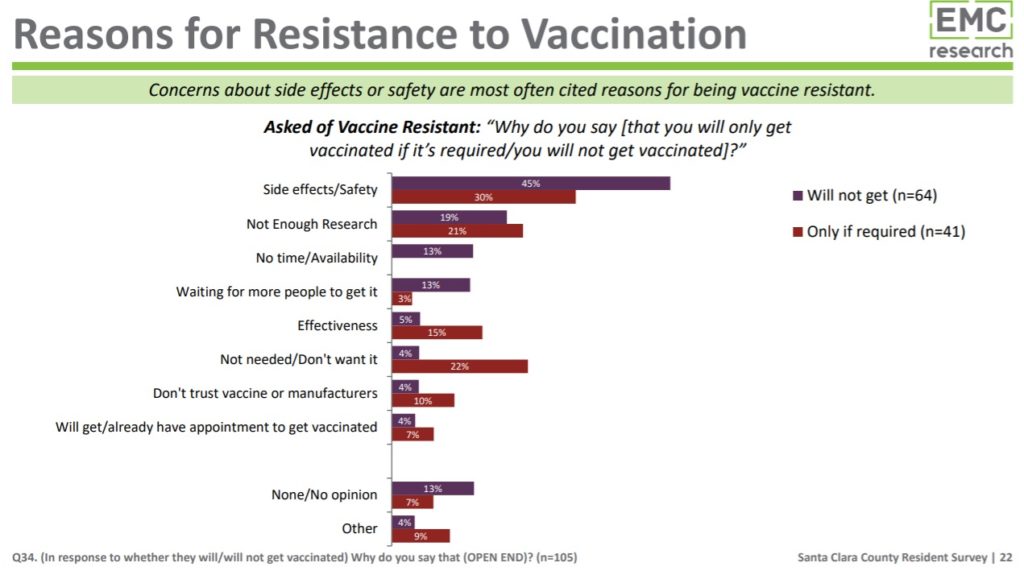San Jose officials are looking to match a lofty goal set by the county: 85% of residents vaccinated by Aug. 1.
City officials on Tuesday introduced a set of priorities for the next three months, including expanding to 20 mobile vaccination sites, partnering with 10 health care providers to distribute vaccines and creating a strategy focused on Latino, Black and Asian American and Pacific Islander residents. The city has a handful of mobile vaccination events in highly-impacted neighborhoods, with three in mid-April and four more events scheduled later this month.
Black and Latino residents have the lowest vaccination rates in the South Bay. With minority groups facing cultural and language barriers along with fewer appointment availabilities in the evening, some residents are forced to choose between skipping work or not getting the vaccine at all.


Councilmember Magdalena Carrasco detailed her vaccination experience from a few weeks ago to illustrate the difficulties Latino residents face to get inoculated. She said she waited in line for three-and-a-half hours at Overfelt High School in East San Jose, only to be told that the supply ran out.
“The people in front of me and the people behind me had been there the day before and they were turned away,” she said. “Now they were turned away a second time. Why would people come back?”
Carrasco is hopeful the city will implement a “wristband” program, where individuals waiting to get a vaccine only for supply to run out will receive a wristband for another appointment.
City officials plan to include detailed information on such a program and providing more evening appointment slots in an update next month. The city also hopes to ramp up digital outreach efforts with more social media content and influencer campaigns in different languages.
As part of the weekly COVID-19 update to the San Jose City Council, officials said the city hit all of its six-month vaccination goals two months early. Some of those goals include expanding vaccination sites, outreach campaigns for the homeless and at-risk communities, developing funding requests to the county and state, providing direct mailers in multiple languages and developing vaccination plans specific to each council district.
“Our goal is to couple vaccinations with more wraparound resources so we go beyond just vaccinating individuals,” said Anh Tran, director of the city’s Vaccine Task Force. Tran noted that the city is increasing incentives for residents to receive vaccines, including health care services and stimulus check signups.


Despite the goals, San Jose and Santa Clara County as a whole still lag behind in COVID vaccination rates.
New county data this week shows one in 10 Santa Clara County residents are refusing a COVID-19 vaccine due to fear of side effects or safety concerns, misinformation and scheduling issues
According to county numbers, 70.8% of residents 16 and over are inoculated with at least one dose of the vaccine. A presentation on Tuesday showed the city’s most unvaccinated neighborhoods are concentrated in East San Jose, as well as areas in Alviso and the Cadillac and Winchester neighborhoods.
Councilmembers floated the idea that more businesses and religious sites could host vaccination events to offer shots to both their employees and community members.
“There’s a lot of trust issues to overcome, and I can’t imagine that anybody would be more effective in overcoming hesitancy than the local minister or priest,” said Mayor Sam Liccardo.
Councilmember Sylvia Arenas asked the city to consider using Spanish-language and other non-English media to reach out to residents and examine data to contact the most affected ZIP codes and census areas—many of which are large Latino neighborhoods.
“There’s some very influential morning shows that I don’t know why we haven’t utilized,” Arenas said. “This is probably a stronger messenger than probably the Catholic church among Latinos.”
Deputy City Manager Kip Harkness pushed to add Spanish-language media outreach to the city’s efforts, and said there’s “no harm in us adding on” to the county’s Spanish-language efforts.
Councilmember Matt Mahan encouraged city officials to consider a daily dashboard to provide updates on the vaccine task force’s canvassing efforts and inoculation rates for each council district.
“As we innovate here, we can share with others,” Mahan said. “We’re not the only city that’s having these challenges. Learning as we do this is important because we can help so many other cities that don’t have the same data capabilities we have.”
As the city begins to emerge out of the pandemic, officials say they’re still preparing in case another spike happens.
“Just as we were in the fall, we need to be—all of us—prepared to walk backwards rapidly if we need to (go) into a more restrictive environment,” Harkness said.
Contact Lloyd Alaban at [email protected] or follow @lloydalaban on Twitter.



Leave a Reply
You must be logged in to post a comment.